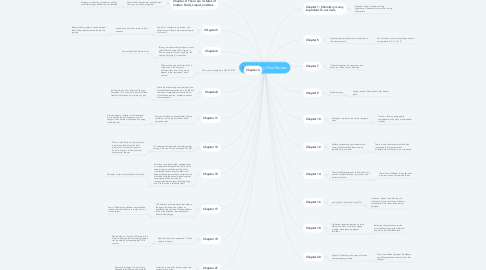
1. Chapter 2: There are 3 states of matter: Solid, Liquid, and Gas.
1.1. Matter has both phyiscal and chemicals changes, as well as properties
1.1.1. Elements, molecules, mixtures, and alloys are different ways Matter can be classified
2. CHapter 3
2.1. The law of constant composition, and daltons atomic theory are important parts of this unit
2.1.1. Atoms have a nucleus, protons, and neutrons
2.1.1.1. Elements have symbols on the periodic table. These elements are also put into groups
3. Chapter 4
3.1. Binary compound always follow a set of rules. Metal is named first. Type 2, a Roman numeral is used to specify the charge. For type 3 it is prefixes.
3.1.1. Same thign with Polytomic ions
4. Chapter 6
4.1. Ome mole of anything is 6.022*10^23
4.1.1. There are the empirical formula of a compound is the simplest whole-number ratio of the atoms present in the compound, while molecul
5. Chapter 8
5.1. There are different types of reactions like Double-Displacement reaction, Acid-Base reactions, single-Replacement reaction, Combustion reaction, Synthesis reaction, Decomposition
5.1.1. 4 driving forces favor Chemical Change: Formation Of a solid, Formation Of water, Transfer of electrons, Formation of a gas
6. Chapter 11
6.1. The pauli exclusion principle states that an orbital can hold only 2 electrons white opposite spins
6.1.1. Electromagnetic radiation is characterized by its wavelength and frequency, can be thought of as a stream of packed of energy called photons
7. Chapter 13
7.1. The ideal gas law describes the relationship among P,V,n,and T for an ideal gas. PV=nRT
7.1.1. There is also Dalton's Law of partial pressures which states the total pressure of a mixture of gases is equal to the sum of the individual pressures of the gas
8. Chapter 15
8.1. Solutions can be Saturated, supersaturate, or unsaturated. Saturated means Contains the maximum possible dissolved solid, Unsaturated means non saturated, and Supersaturated means that it contains more dissolved solid than should dissolve given temeperature They can also be concentrated which means relatively large, and Dilute, which is relatively small
8.1.1. Molarity= moles of solute/liters of solution
9. Chapter 17
9.1. LE Chatelier's principle states that when a change is imposed on a system at equilibrium the position of the equilibrium shifts in the direction that reduces the effect of that change
9.1.1. Law of Chemical equilibrium is established when a chemical reaction is carried out in a closed vessel
10. Chapter 19
10.1. Half-Life is the time required for 1/2 the sample to decay.
10.1.1. RadioCarbon or Carbon-14 Dating is the method where objects containing carbon can be dated by measuring their 14/6 content
11. Chapter 21
11.1. Proteins are natural polymers ,made from various amino acids
11.1.1. There are 4 classes of Lipids. Fats, Phospholipids, Waxes, and steroids
12. Chapter 1: Chemistry is very important To our lives.
12.1. Scientific method involves making hypothesis, observations, as well as doing Experiment
13. Chapter 5
13.1. Signficant figures reflects the uncertainty of the measurement
13.1.1. You also have convert many things such as temperature (F to C, C to K)
14. Chapter 7
14.1. Chemical equation has reactants, and products. It also uses coefficients
15. Chapter 9
15.1. Stoichiometrey
15.1.1. Linting reactant, Theoretical yield, Percent yield
16. Chapter 10
16.1. Enthalpy is a process that is the change in heat
16.1.1. Heat is a flow on energy while temperature is the vigor of the random motions
17. Chapter 12
17.1. Molecular geometry can be described using the valence shell electron pair repulsion Vsper model
17.1.1. There is also Lewis structure which also represents the valence electron arragements of the atoms in a compound
18. Chapter 14
18.1. There is different types of solids in this unit such as Crystalline solids, ionic solid, and molecular solids.
18.1.1. There is also Different forces like inter, intra, and London dispersion forces
19. Chapter 16
19.1. pH=-log[H+], and pOh=-log[OH-]
19.1.1. A titration is when the deloivery of a measured volume of solution of known concentration into the solution being analyzed
20. Chapter 18
20.1. Oxidation-reduction reactions involve electron transfer,. Oxidation agents accepts, while reducing Agents furnishes
20.1.1. Balancing these reactions can be accomplished by using 2 methods. Inspection, and Half-Reactions.
21. Chapter 20
21.1. Organic Chemistry is the study of carbon containing components.
21.1.1. There are different groups Like Alkenes and Alkynes that are mentioned in this chapter.

